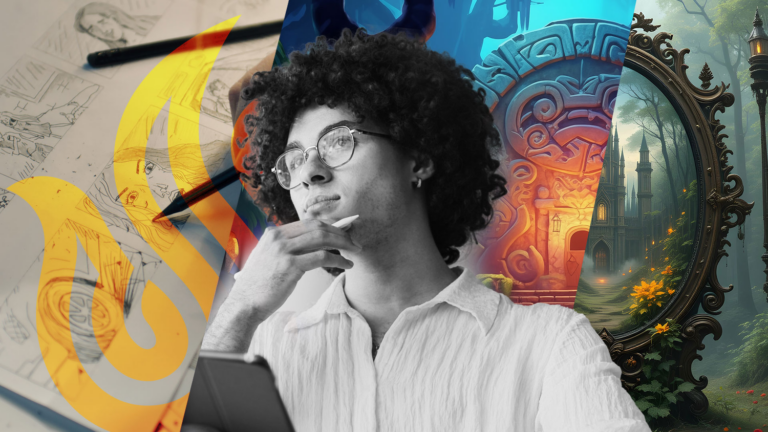Producing a one-minute animation can be serious business. For the USV students who came up with the story, the setting and the animations for The Brink, it also represents an award-winning portfolio piece. At the end of their Fall semester classes, the students submitted their piece to the Animation Career Review’s 2017 Christmas Holiday Short Animation Contest and walked away with 1st Place and a $1,000 prize.
Remarkably, the students in this Animation Portfolio class expected they would be working on individual pieces. Little did they know they would be devising story ideas, recruiting talent from other classes, and producing an original piece as a team.
The Brink is the story of a man who is struggling with the loss of someone he cared about. Will he succumb to his grief or overcome it? This was a group project led by Nikki DelVecchio, Natallia Dushkova, Victoria Haimov and Jean-Pierre Rouleau. Animation, Rigging, Lighting, and Rendering was done in Autodesk Maya 2017. Compositing was done in Nuke 10. Video editing was done in Adobe Premiere Pro CC 2017. The contest rules specified that each entry included a short audio segment, which in The Brink was the device used to bring the main character back to his senses.
But these details only touch on the experience. The Animation Portfolio Class got started brainstorming ideas for a theme and a storyline during their first week of class. Those ideas were refined, the story was written down and rough storyboards were produced in the next two weeks. The story was then revised with regards to both design and structure to bring out a sense of conflict and resolution. While the initial goal was for a 30-second short, the finished work came in at just over a minute in length. Given that all students were involved with other classes, with other assignments with due dates, and given that the sound, lighting, compositing, rendering and other technical aspects of the animation would be performed by students in other classes, the group knew they were under a tight operational timeline.

Some of the team met near the end of the semester:
Nicholas Hall was recruited to produce the audio track. “My audio director told me, ‘Listen, there’s an audio gig out there that can use your skills for both sound design and composition’, so I took a look at the animatic with time-code and said, ‘Yes’. This story is different than what would typically be told. It’s a lot more intense than most.”
“I was brought in to lead the lighting team, and then the compositing team as well”, said Griffin Bajor. In the end, this group swelled to eight students to bring the project to life. “We modeled, we lit, we found ourselves troubleshooting interesting problems with the rigs and what-not along the way.” With rendered results and pretty lights, the final compositing steps put all the layers together to achieve the final look of the finished product.
Nikki DelVecchio was inspired by the feedback the team received from industry experts. “The on-going critiques would put us in a new mindset. We had been reviewing the story week after week, and we would get used to it, but a fresh perspective from an outsider made me discover I could work harder to bring out a better story.” Knowing how to tell stories and how to animate, professionals from industry provided feedback which enabled the team to see their work with fresh eyes. Subtle nuances helped push the emotions of the scenes and helped the team “sell” the story better.
Jean-Pierre Rouleau appreciated the challenges. “I approach everything differently now, after taking this class. I really developed the notion of constraint animation. To stack three photographs in a hand, then have them disconnect from the hand one by one required me to constrain them to the hand then leave the hand naturally, even using paper-thin rigs.”
Victoria Haimov took away an appreciation for the way the team found something deeper than what might seem clear at first. “I learned about going back over the story to find the beats. We had moments where we had to meet as a team to make sure everything worked together. Those brainstorming sessions were a lot of fun.”
Natallia Dushkova reflected on how the project broadened her perspectives. “When we started the project, I think we each focused on our shots and how they worked. But, as we progressed, we had to think about all of the shots and how they worked together. Where does this shot start from, and where does it go? It was very challenging.”
For all involved, this was a new way of producing a portfolio piece. At the beginning of the semester, some of the students expected they would be producing their own pieces individually. Said Jean-Pierre Rouleau, “It’s much more rewarding to work as a group and have these clips come together and tell an actual story!” Working in pipeline production and making a film with a team has a different “feel” than working solo. Everyone agreed, the combined strengths of the team helped them try out new approaches to come up with something extraordinary.
Nikki DelVecchio summed the value of the experience for the entire group. “You end up thinking about it all the time. We were on Slack, our messaging system, every day, talking about the project. Some of us hardly saw each other in person but we were still able to be a team. In the end, we came away with something we are really proud of.”


